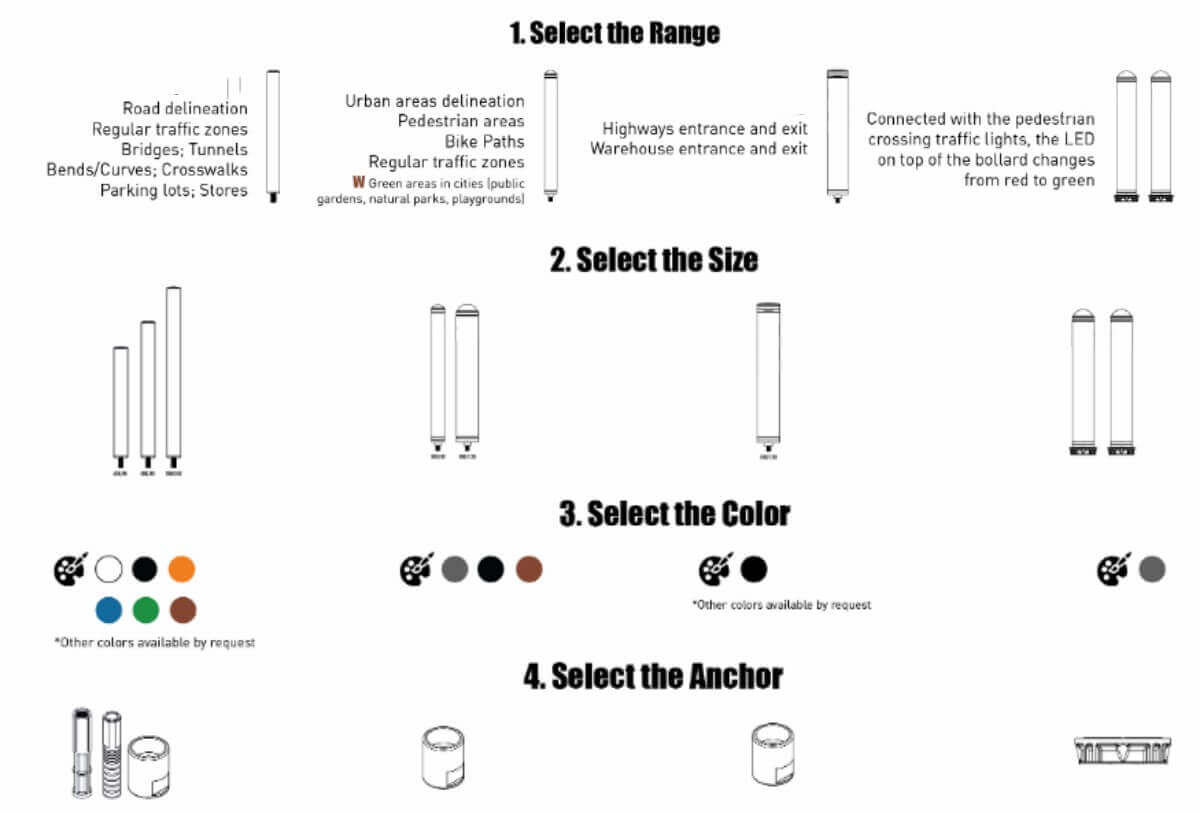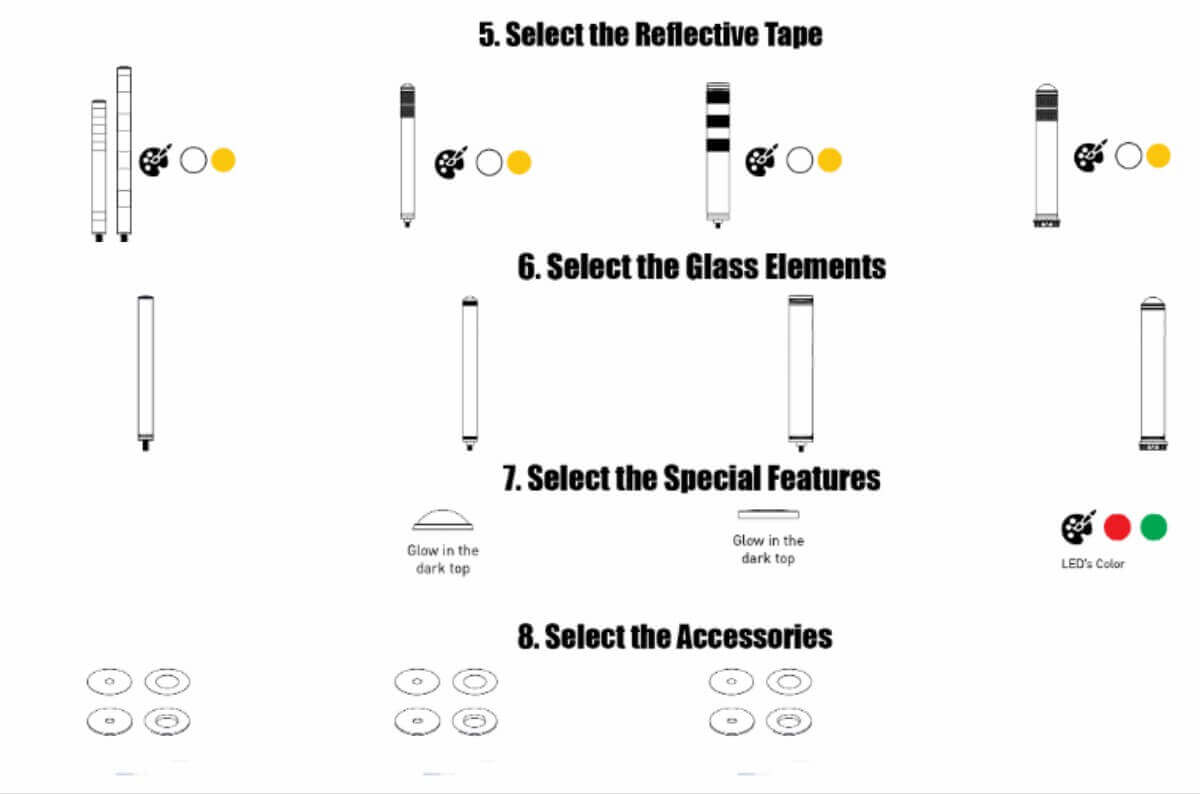Driving today has become synonymous with danger as we face more distractions than ever before. Some drivers are overconfident in their driving abilities, while others use mobile devices while driving. Any of these actions could result in a life-threatening situation. In order to reduce the occurrence of this situation, flexible bollards came into being.
Flexible bollards are brightly colored and feature highly reflective tape and crystals, greatly improving driver perception. Due to their high visibility effect, these bollards can prevent serious accidents. In today’s guide, we’ll take a look at flexible bollards. Read on to learn more.
1. What are flexible bollards?
Flexible bollards are made from durable, flexible material. This allows them to flex and return to shape when impacted, reducing the risk of vehicle damage. Flexible bollards are designed to separate pedestrian/cycling areas from traffic in high-traffic areas. It can also be used to control road traffic, restrict access to dedicated areas, monitor traffic, and prevent break-in attacks.
When a vehicle collides with a flexible pillar, it will simply make a loud noise and stop. Flexible bollards are made with highly reflective tape and crystals, making them visible even in low light or at night. Because flexible bollards can withstand repeated impacts from vehicles without deforming, they are ideal for high-traffic areas where collisions are common, making them an ideal non-impact guardrail solution.

2. Advantages of flexible bollards
The following are the advantages of flexible bollards.
1) High memory effect and impact resistance
Flexible bollards are particularly useful at night as they feature highly reflective strips that improve visibility at night. Flexible posts are often used to delineate vulnerable areas, but when used on motorways they can also serve as tactile warnings for vehicles.
2) Resistant to light and heavy vehicles
If a vehicle accidentally hits a flexible bollard, the bollard will simply bounce back, causing little or no damage to the vehicle. These traffic bollards are typically used in parking spaces in commercial or residential areas where drivers need to back up more often.
3) Returns to its original form almost immediately
If a car collides with a flexible bollard, it simply bounces back into place, causing little to no damage to the vehicle.
4) UV Protection for Improved Durability
Installed outdoors, using highly durable materials.
5) Flexible
Highly flexible and can be bent at will.
6) Cost Effectiveness
Flexible bollards can save costs in the short and long term. In the short term, they are cheaper and easier to install than heavier physical barriers. They save replacement costs in the long run because they don’t need to be replaced after every crash. They will also continue to put their best foot forward with as little attention as possible.
7) Wide range of applications
various colors and sizes to suit a variety of applications
8) High Visibility
Flexible bollards serve as a visual reference to cars, indicating where they can travel.
9) Easy Installation
Flexible bollards are easy to install and require little to no maintenance.
10) Street bollards increase driver awareness
Street bollards are the perfect height to allow drivers to see without obstructing their view. Drivers are able to perceive distance and space more accurately when they are installed along road boundaries. When bollards are installed in series along a straight road or around a curve, they create the illusion of speed, or more specifically, they draw attention to themselves as they quickly move in and out of your field of view.
As a result, drivers are also encouraged to slow down. Bollard color and size can affect driver visibility. Bollards or reflective bollards with reflective surfaces may be ideal for low light or nighttime conditions.

3. Types of bollards
Below are the different types of bollards.
1) Divide by color
The flexible bollards are available in black and white or red and white and can be used with different fixings.
#1. Black and white flexible traffic bollards
Black and white flexible bollards made from high-gloss flexible polyurethane with reflective strips for increased visibility. They are mounted using three M12 mounting bolts.
The main features are:
- Extremely tough and durable.
- Flexible under impact.
#2. Red and white flexible traffic bollards
Red and white flexible traffic bollards made from durable thermoplastic polyurethane in a one-piece design. Secure the integrated base to a suitable surface using three M10 bolts.
The main features are:
- Wear-resistant.
- Reduce the risk of damage.
- Telescopic to return to upright position.
#3. Red and white off-highway flexible traffic bollards
Red and white off-highway traffic bollards constructed from polyethylene with highly visible reflective sleeves. The bollard pivots at its base, and a chain is used to pull the bollard back to an upright position after an impact. The base is made from recycled materials and mounted using five M10 bolts. Off-highway traffic bollards are not intended for use on public highways.
Application areas:
Traffic lane separation, guide traffic, warn traffic obstacles.
The main features are:
- durable.
- Highly visible.
- adjustable
- Easy to install.
2) Divide according to impact intensity
The majority of bollards fall into one of two categories: impact-resistant or non-impact-resistant.
#1. Impact Resistance
Impact-resistant bollards serve as both a visual reminder and a physical barrier. They are heavy-duty, sturdy posts that can stop a moving vehicle—but only once. Impact-resistant bollards can bend or crack under impact, so they need to be replaced after every crash. That said, the sacrifice is well worth it to protect vulnerable pedestrian areas from fast-moving vehicles.
#2. Non-impact resistant
Non-impact-resistant bollards, also known as flexible bollards, do not rely on physical force to restrict vehicle movement. Instead, they prevent collisions by alerting drivers to restricted areas and encouraging safe driving habits. If a driver accidentally hits a car, they will feel a slight resistance rather than a hard stop.
Flexible bollards are designed to fold under pressure so neither the vehicle nor the bollard is damaged. This is great for high-traffic areas with low-speed limits but is less effective at protecting pedestrians from fast-moving out-of-control vehicles. As with most traffic safety measures, it’s all about location.

3) Bollards used to stabilize traffic
Street bollards can be used on their own to manage road behavior, but they are often used as part of a wider traffic calming strategy. Traffic calming is a design approach designed to encourage safer and more responsible driving. Implementing traffic calming in busy areas (especially in areas with mixed traffic modes and/or high pedestrian numbers) can improve safety and reduce the risk of accidents. It usually uses a mixture of both methods.
- Physical modifications: These include reducing street/lane widths; installing roundabouts, traffic circles, medians, and boulevards; directing traffic flow; and installing vertical deflections and other surface treatments.
- Visual cues: These include signage and other design elements such as traffic stripes.
Temporary traffic cones and freestanding posts are often used to temporarily delineate lanes, but they are not as strong as bollards. Where traffic cones and pillars can easily be knocked over or deformed, flexible bollards – designed to withstand repeated impacts – are ideal for maintaining visual barriers over the long term.
4. Factors to consider when designing flexible bollards
When designing flexible bollards, whether they are physical or visual barriers, consider these key factors.
- Physical Requirements: Does your building or property require physical protection? If so, what types of threats are expected given the location and surrounding proximity?
- Aesthetic considerations: What are the visual expectations when looking at the property and surroundings? High-end buildings should have furniture that matches their planning and design. Industrial areas may not have the same expectations. Depending on the neighborhood or community, one can expect different things from commercial and residential environments.
- Risk of impact or physical contact: A range of factors can affect the likelihood of vehicle intrusion, including traffic volume, driver behavior, vehicle speed, and distance. If regular impacts are expected, it is important to consider how these barriers will be maintained or replaced.
- Cost: Whether it’s physical protection, decorative elements, or long-term care and maintenance, it all adds up. A clear budget will help you evaluate and prioritize your surrounding needs.
Factors such as distance, installation method, and ground surface, as well as vehicle type, size, and approach speed, will all affect the effectiveness of any perimeter barrier. For any bollard installation that requires physical protection, always work with a qualified engineer.

5. How to choose the right flexible bollard for your project?
Over the years, Aotons has developed a range of flexible bollards suitable for different types of applications. They are used to form physical and visual barriers, guide vehicles, prevent access to restricted areas, regulate pedestrian and vehicular traffic, and improve landscaping and design. They can also warn pedestrians about crosswalk lights.
1) Selection range
2) Select size
3) Choose color
4) Select anchor
Anchors allow the bollard to be installed directly into the ground, making installation easier and allowing the bollard to absorb contact from an accident while limiting damage to the bollard and vehicle.

5) Choose reflective tape
6) Select glass elements
7) Select special features
8) Choose accessories
It is possible to produce rubber gaskets and plastic gaskets by cutting rubber or plastic. Maintenance accessories are used in the maintenance process of bollards to make it easier to connect or remove the bollards from the sidewalk. prevent the glue from entering the base. It must be installed at the bottom of the bollard to improve maintenance processes.

6. Conclusion
In summary, if you are looking for an effective way to clearly differentiate between pedestrian/bike and vehicle traffic, protect a building from damage, or simply enhance the overall appearance of your location, then Flexible bollards are your best choice. Contact Aotons to find the right bollards for your project today.





Leave A Comment